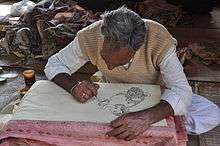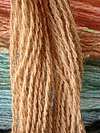Kalamkari
Kalamkari is a type of hand-painted or block-printed cotton textile, produced in Isfahan and Indian states of Andhra Pradesh and Telangana. Only natural dyes are used in Kalamkari and it involves twenty-three steps.
There are two distinctive styles of kalamkari art in India - Srikalahasti style and the Machilipatnam style. The Srikalahasti style of Kalamkari(Kalankari), wherein the "kalam" or pen is used for freehand drawing of the subject and filling in the colors, is entirely hand worked. This style flowered around temples and their patronage and so had an almost religious identity - scrolls, temple hangings, chariot banners and the like, depicted deities and scenes taken from the Hindu epics - Ramayana, Mahabharata, Purana and the mythological classics. This style owes its present status to Kamaladevi Chattopadhyay who popularized the art as the first Chairperson of the All India Handicrafts Board.
Etymology
Historically, Kalamkaris used to be known as Pattachitras, an art form still found in neighboring Odisha and other parts of India and Nepal.[1] The term "Pattachitra" in (Sanskrit:पट्टचित्र) translates to "Patta" meaning "cloth" and "Chitra" means "picture".[2] Paintings made on fabric and fabric scrolls finds mentioned in ancient Hindu, Buddhist and Jain literature.[3][4]
Under medieval Islamic rule, the term Kalamkari Persian,قلمکار which is derived from the words kalam (pen) and kari (craftmanship), meaning drawing with a pen came to be in popular use under the patronage of Golconda sultanate.[5]
History

_-_overall.jpg)
In ancient times, groups of singers, musicians and painters, called chitrakars, moved from village to village to tell the village dwellers, the great stories of Hindu mythology. They illustrated their accounts using large bolts of canvas painted on the spot with simple means and dyes extracted from plants. In the same way, one found in the Hindu temples large panels of kalamkari depicting the episodes of Hindu mythology and iconography, similar to Buddhist Thangka paintings.
As an art form it found its peak in the wealthy Golconda sultanate, Hyderabad, in the Middle Ages. The Mughals who patronized this craft in the Coromandel and Golconda province called the practitioners of this craft "qualamkars", from which the term "kalamkari" evolved.[6] The Pedana Kalamkari craft made at Pedana nearby Machilipatnam in Krishna district, Andhra Pradesh, evolved with the patronage of the Mughals and the Golconda sultanate. Owing to the said patronage, this school was influenced by Persian art under Islamic rule.[5]
Kalamkari art has been practiced by many families in Andhra Pradesh, some villages in Tamilnadu (Sickinaickanpettai) by migrants from Telugu speaking families and over the generations has constituted their livelihood. Kalamkari had a certain decline, then it was revived in India and abroad for its craftsmanship. Since the 18th century the British have enjoyed the decorative element for clothing.
Middle forms
In middle ages the term is also used to refer, incorrectly, to the making of any cotton fabric patterned through the medium of vegetable dyes by free-hand painting and block-printing, produced in many different regions of India. In places where the fabric is block printed the kalam (pen) is used to draw finer details and for application of some colours.First it was introduce in blue colour.
In this Century (Digital era)
In modern times it's replaced by digital. The art took a turn-over and updated digitally to fit in the glove of time. In this era new types and new techniques are introduced and the digital files of kalamkari (pen work) is totally introduced widely all over the regions of India and Iran (Persia).
Recent times in India, Silk, Mulmul, Cotton and Synthetic Sarees are also sold with Kalamkari print. Printing is much easier task then Original Kalamkari work. Kalamkari duppattas and blouse pieces are popular among Indian women.
Technique
Seeping it in astringents and buffalo milk and then drying it under the sun.[7] Afterwards, the red, black, brown, and violet portions of the designs are outlined with a mordant and cloth is then placed in a bath of alizarin.[7] The next step is to cover the cloth, except for the parts to be dyed blue, in wax, and immerse the cloth in indigo dye. The wax is then scraped off and remaining areas are painted by hand,[7] similar to Indonesian batik.
To create design contours, artists use a bamboo or date palm stick pointed at one end with a bundle of fine hair attached to this pointed end to serve as the brush or pen.[8] This pen is soaked in a mixture of fermented jaggery and water; one by one these are applied, then the vegetable dyes.
In Iran, the fabric is printed using patterned wooden stamps.[9]
Color fixing
Dyes for the cloth are obtained by extracting colors from various roots, leaves, and mineral salts of iron, tin, copper, and alum.[8] Various effects are obtained by using cow dung, seeds, plants and crushed flowers to obtain natural dye. Along with buffalo milk, myrobalan is used in kalamkari. Myrobalan is also able to remove the odd smell of buffalo milk. The fixing agents available in the myrobolan can easily fix the dye or color of the textile while treating the fabric. Alum is used in making natural dyes and also while treating the fabric. Alum ensures the stability of the color in kalamkari fabric.
Themes
Kalamkari specifically depicts epics such as the Ramayana or Mahabharata. However, there are recent applications of the kalamkari technique to depict Buddha and Buddhist art forms.[10]
References
- Roy Niranjan (1973), The Patas and Patuas of Bengal. Indian Publications Calcutta, Page number 54-55 (Annexure C,V)
- SenGupta, pp. 12.
- Ray, Himanshu Prabha (2004). "Far-flung fabrics – Indian textiles in ancient maritime trade". In Barnes, Ruth (ed.). Textiles in Indian Ocean Societies. Routledge. p. 31. ISBN 113443040X.
- Devare, Hema (2009). "Cultural implications of the Chola maritime fabric trade with Southeast Asia". In Kulke, Hermann; Kesavapany, K.; Sakhuja, Vijay (eds.). Nagapattinam to Suvarnadwipa: Reflections on the Chola Naval Expeditions to Southeast Asia. Singapore: Institute of Southeast Asian Studies. p. 185. ISBN 9812309373.
- "Indian Painting". Indian Culture and Heritage (PDF). New Delhi: National Institute of Open Schooling. 2012. Retrieved 18 October 2017.
- Bhatnagar, Parul. "Kalamkari". Traditional Indian Costumes and Textiles. Retrieved 20 September 2011.
- Sardar, Marika (October 2003). "Indian Textiles: Trade and Production". Heilbrunn Timeline of Art History. Metropolitan Museum of Art.
- "Paintings: Kalamkari Paintings". Indian Heritage. April 2006. Retrieved 3 April 2016.
- Held, Colbert C. (2006). Middle East patterns: places, peoples, and politics. Boulder, Colo: Westview Press. ISBN 0-8133-4170-1.
- Naidu, T. Appala (20 July 2015). "Techie's Twist to Kalamkari". The Hindu.
Further reading
- Kossak, Steven (1997). Indian court painting, 16th-19th century. New York: Metropolitan Museum of Art. ISBN 0870997831. (see index: p. 148–152)
